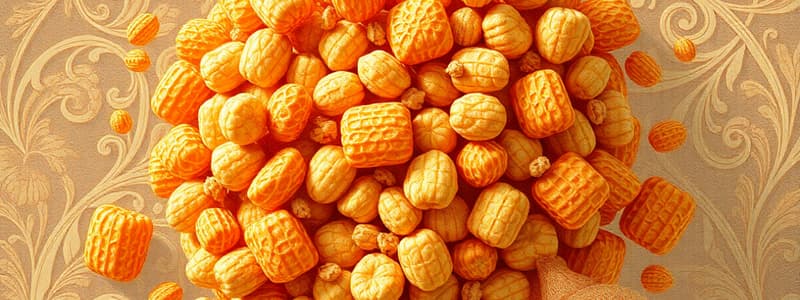Podcast
Questions and Answers
What is the simplest form of carbohydrates?
What is the simplest form of carbohydrates?
- Monosaccharide (correct)
- Polysaccharide
- Disaccharide
- Oligosaccharide
Which type of linkage in starch can be broken by both mammalian and microbial enzymes?
Which type of linkage in starch can be broken by both mammalian and microbial enzymes?
- Delta linkages
- Beta linkages
- Gamma linkages
- Alpha linkages (correct)
In the ruminant digestive system, which part is primarily responsible for carbohydrate digestion?
In the ruminant digestive system, which part is primarily responsible for carbohydrate digestion?
- Reticulorumen (correct)
- Large intestine
- Stomach
- Small intestine
Which end products are primarily formed from carbohydrate fermentation in ruminants?
Which end products are primarily formed from carbohydrate fermentation in ruminants?
Which type of carbohydrates can only be digested and utilized by microbes?
Which type of carbohydrates can only be digested and utilized by microbes?
What is the main dietary carbohydrate for monogastric animals?
What is the main dietary carbohydrate for monogastric animals?
Which type of carbohydrate sources is primarily utilized in the horse's diet?
Which type of carbohydrate sources is primarily utilized in the horse's diet?
What are the primary short chain fatty acids produced from rumen fermentation of carbohydrates?
What are the primary short chain fatty acids produced from rumen fermentation of carbohydrates?
What type of acid is primarily associated with high starch diets?
What type of acid is primarily associated with high starch diets?
Which statement is true about lignin?
Which statement is true about lignin?
What is the primary component of rumen gas?
What is the primary component of rumen gas?
What effect does the addition of unsaturated fatty acids to a ruminant's diet have?
What effect does the addition of unsaturated fatty acids to a ruminant's diet have?
Which factor does NOT influence microbial digestion of crude fiber?
Which factor does NOT influence microbial digestion of crude fiber?
What is a consequence of increasing lignin content in plants?
What is a consequence of increasing lignin content in plants?
What happens to methane production when carbohydrates are digested in ruminants?
What happens to methane production when carbohydrates are digested in ruminants?
Which method is ineffective in lowering the digestibility of crude fiber?
Which method is ineffective in lowering the digestibility of crude fiber?
Flashcards are hidden until you start studying
Study Notes
Carbohydrates
- Chemically, carbohydrates are composed of carbon, hydrogen, and oxygen.
- Carbohydrates are the main source of energy for animals.
- The simplest form of a carbohydrate is a monosaccharide.
- Monosaccharides include glucose, fructose, and galactose.
- Two monosaccharides link to form a disaccharide.
- Disaccharides include sucrose and lactose.
- Polysaccharides are composed of three or more monosaccharides.
- Starch and cellulose are the two primary polysaccharides.
- Glucose molecules in starch are linked via alpha linkages.
- Alpha linkages can be broken down by both mammalian and microbial enzymes.
- Glucose molecules in cellulose are linked via beta linkages.
- Beta linkages can only be broken down by microbial enzymes.
- Feedstuffs high in starch include grains.
- Feedstuffs high in cellulose include forages.
- Other carbohydrates include pectins and hemicellulose.
- Pectins and hemicellulose are only digested and utilized by microbes.
Carbohydrate Digestion and Absorption
- Monogastric Animals:
- Starch is the primary carbohydrate in monogastric animal diets.
- Starch is digested by pancreatic amylase in conjunction with other enzymes in the small intestine.
- Monogastrics can also utilize forages with the help of their microbial population.
- Horses have the greatest utilization efficiency of fibrous compounds.
- Ruminants:
- The primary site of carbohydrate digestion is the reticulorumen.
- Dietary carbohydrates are initially subject to rumen microbial digestion.
- The main substrates for rumen microbial digestion include sugars, starch, hemicellulose, and cellulose.
- The end products of digestion in ruminants are volatile fatty acids and some monosaccharides.
- The primary end-products of rumen fermentation of carbohydrates are short-chain fatty acids (SCFAs) such as acetic acid, propionic acid, and butyric acid.
- SCFAs are absorbed across the rumen or the small intestine and metabolized to produce energy-yielding compounds such as glucose.
- High starch diets are characterized by relatively higher propionic acid levels.
- Fiber diets are characterized by higher acetic acid levels.
- Intestinal digestion of carbohydrates is limited in mature ruminants.
Lignin
- Lignin is a polyphenolic polymer associated with fibrous feedstuffs.
- Lignin is indigestible by both microbial and mammalian enzymes.
- Lignin reduces the digestibility and availability of nutrients in feedstuff.
- The lignin content increases as the plant matures.
Gas Production
- Methane is a primary component of natural gas and a greenhouse gas.
- The typical composition of rumen gas is CO2 (40%), methane (30-40%), H2 (5%), and small proportions of O2 and nitrogen.
- Ruminants lose about 7% of their food energy as methane.
Lowering Methane Production
- Adding unsaturated fatty acids to the ration can help reduce methane production.
- Unsaturated fatty acids are saturated by rumen microorganisms, requiring hydrogen in the process, which reduces methane formation.
Factors Governing Microbial Digestion of Crude Fiber
- Animal factors:
- Species of animal
- Age of the animal
- Ruminal environment
- Sudden changes in ration can affect rumen microorganisms adaptation.
- Ration effects on rumen pH.
- Effects of antibiotics on the ration.
- Animal health condition.
- Plant factors:
- Age of the plant
- Type of roughage
- Ration composition:
- Starch and soluble carbohydrates
- Dietary protein levels
- Minerals and vitamins (Cobalt is essential for microorganisms)
- Feed preparation:
- Alkali treatment of roughage can increase its degradability.
- Grinding roughage can reduce crude fiber digestibility.
- Pelleting roughage can decrease crude fiber digestion due to the increased rate of passage.
Studying That Suits You
Use AI to generate personalized quizzes and flashcards to suit your learning preferences.



